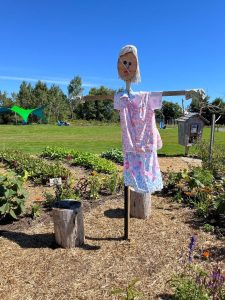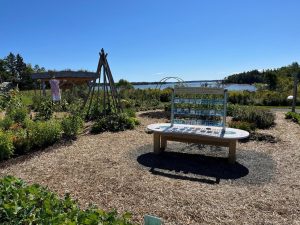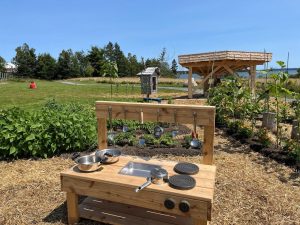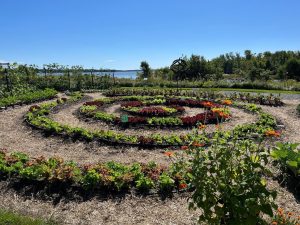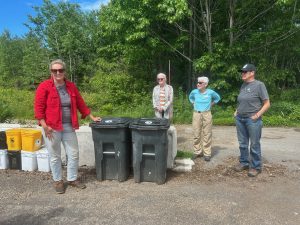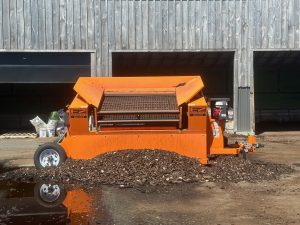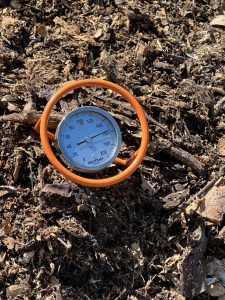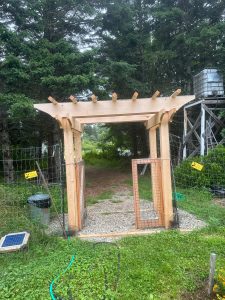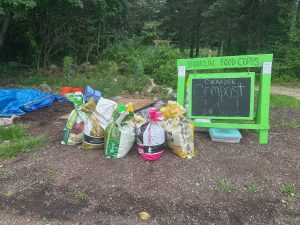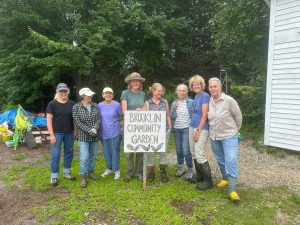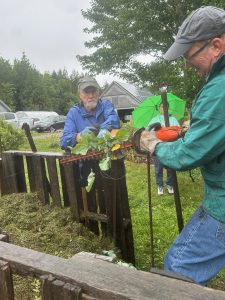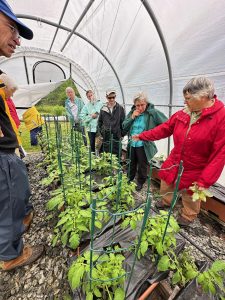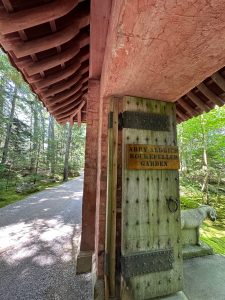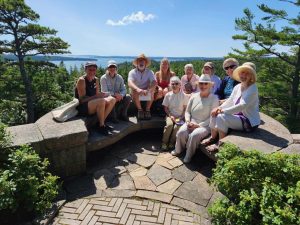Master Gardener Volunteers – Hancock County Newsletter – September 2024
Table of Contents
PROJECT PROFILE – INCREDIBLE MILBRIDGE/ CHICKADEE COMPOST / BROOKLIN GARDENS/ SWEET HAVEN FARM / ROCKEFELLER GARDENS / BEECH TREES! / MGV BOOK CLUB
Upcoming Dates to Remember!
Sept 7 Four Season Farm Tour – all invited!
Sept 9 MG Advisory Meeting
Sept 22 First Day of Fall
Oct 7 MG Advisory Meeting
Oct 14 Indigenous Peoples’ Day – Office Closed
What a summer it has been. It’s hard to believe that it’s coming to an end. We have had some wonderful field trips, and liaison visits to project gardens, many of which are highlighted in this issue.
Perhaps the most exciting news it that we have a new Master Gardener Volunteer Coordinator! His name is David Lowe. He started in July and the Master Gardener Advisory Committee welcomed him via Zoom at their August 5th meeting. He is a Sustainable Agriculture and Horticulture Specialist. David lives in Aroostook County with his wife and three-year-old son. He will coordinate the Master Gardener Volunteer Programs for Aroostook, Washington, and Hancock Counties. David will also field the horticulture questions and concerns from walk-in customers, phone inquiries, or emails in all three counties. He is looking forward to visiting some of our community gardens and meeting with Master Gardener Volunteers in the upcoming weeks. David can be reached at david.alan.lowe@maine.edu, 207-764-3361 (office).
And something special! A Bobcat visited the Extension Office a couple weeks ago. Playing under the River Birch, catching moles.
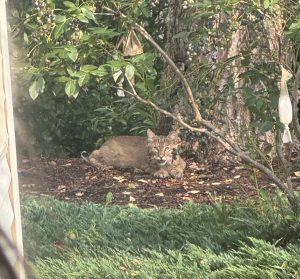
MGV Project Profile
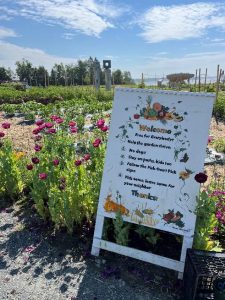
The Beautiful, INCREDIBLE EDIBLE MILBRIDGE
by Lynne Altvater, MGV
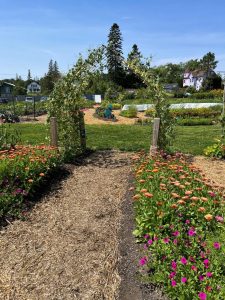
Hello! My Master Gardener Volunteer assignment brought me last year to Incredible Edible Milbridge (IEM), a series of public vegetable gardens in Milbridge, Maine. A quick 30-minute drive from downtown Ellsworth, IEM is more than just gardens; it also offers education initiatives designed to create a stronger, healthier, and more food-independent community. IEM is funded and managed by the Women for Healthy Rural Living (a 501(c)3 non-profit organization) in conjunction with the Maine Seacoast Heritage Trust, and is supplemented by grants and private donations. Since its inception in 2013, more than 100 volunteers have contributed to help transform Incredible Edible Milbridge into a reality. A sense of community pride comes with an activity that unites people and creates beauty where there was none. IEM relies on the help of the Master Gardener Volunteer pool to address the community food insecurity crisis. Between IEM and the adjacent Red Barn Hotel garden, more than 10,000 pounds of vegetables are grown every year. Community members, school children, colleges, and local businesses also invest countless hours planting, weeding, and harvesting the garden.

The garden has a quarter-mile walking path around its perimeter with views of the perennial pollinator garden, eclectic playground, and a picturesque waterfront. A granite sitting area is frequented by picnickers and other groups, including the Pleasant River Garden Club of which I am a member. People within the community often spend their lunch break walking the paths and always remark on the beauty and transformation of this once-barren space. IEM is truly a hidden gem and a must-see for all.
The project has been designed to support the entire community and has a unique Children’s Garden, complete with a learning center, children’s kitchen, a living roof and reading nook. A beautiful playground is adjacent to the garden. IEM holds workshops and provides other learning opportunities for the little ones and adults alike.
- Inside of the Children’s Garden area
- Children’s Learning Center
- Garden kitchen, living roof in the background
I have spent many a day volunteering in the Salad Bowl, which is an artistic beauty of never-ending color and texture throughout the growing season.
- Salad Bowl Garden in September
- Prettiest Compost Bin ANYWHERE!
For more information, I encourage you to check out their website with links to workshops and other topics of interest. Please come visit the garden, you won’t be disappointed! IEM Website: https://whrl.org/programs/incredible-edible/
Photos courtesy of Lynne Altvater /MGV
Chickadee Compost Field Trip
On June 10th, eight of us met with Kate Tomkins, founder of Chickadee Compost, at Chickadee Headquarters in Surry. Kate gave us a tour and explained how the process works, from dropping off your full home compost buckets to selling the finished product. It is an impressive operation.
The temperature is checked on each pile daily. The result will determine whether the pile needs to be turned or moved or let alone to heat up some more.
Households as well as businesses may take part. Many people subscribe in the winter, and then suspend their account during the summer when they can do their own composting. There are a number of locations where you can pick up the buckets, and return them and get clean ones. It was very educational and surprisingly, didn’t smell bad.
- MG Volunteers learning about the processing of Chickadee Composting
- Compost Equipment at Chickadee Compost
- Compost Thermometer
For more information go to: https://www.chickadeecompost.com/
Brooklin Community Garden
I made a Liaison visit to the Brooklin Community Garden on July 11th. The director of the garden is Lisa DePasqual, MGV. The purpose of liaison visits is to speak with MGVs involved in the project and, among other things, see if there’s anything they need from the Extension Office. In this case, Patty Persson is the only other MGV involved. Lisa’s only request was an MGV sign to put in the garden – which Sue Baez was happy to deliver.
Gardeners meet twice a week, with a rotating collection of volunteers. On this day, by the time I got there, there were six other volunteers in addition to Lisa and Patty. Their session had ended early but Lisa was gracious enough to give me a tour and some of the volunteers stayed as well.
The garden is beautiful. There is a lovely non-electrified gate for easy access, but the rest of the surrounding area is electrified. There are three sisters plantings (corn, beans, and squash), more rows of corn, and other vegetable beds surrounded by marigolds and other flowers to deter insect pests. They have a compost pile, and their water is pumped from a water tower next to the garden. Every year there are about 10 plots allocated to individuals. The rest are teaching plots for Brooklin students, maintained by community volunteers. The produce from the teaching plots is all donated to the Magic Food Bus.
They hold workshops, seed and seedling swaps, and other activities throughout the year. They also have self-serve sales of Chickadee compost outside the garden.
- Arbor Entrance to the Brooklin Community Gardens
- Produce at Brooklin Community Gardens
- MGV’s and other gardening volunteers at Brooklin Community Gardens
My visit ended with a group trip to the Morning Moon Café for a delicious breakfast.
Sweet Haven Farm Field Trip
On a very rainy Tuesday morning, July 23rd, a group of 10 Master Gardener Volunteers gathered at Sweet Haven Farm in Seal Cove to see and learn all about the processes that go into this lush and bountiful vegetable garden. Dorcas Corrow manages this effort and graciously described seed starting on through to garden production and composting. The vegetables are grown in hoop houses, raised beds and field gardens. The compost production is handled by Tom McIntyre and Frank Hague who have perfected their process to produce a fine end product for use on all the plants. The farm has been raising vegetables for several limited-income housing sites since 2010.
- Raining Day at Sweet Haven Farm
- Tom and Frank demonstrate the process of their composting at Sweet Haven
- Dorcas shows the great work her volunteer team is doing in the hoop house at Sweet Haven Farm
Abby Aldrich Rockefeller Gardens Field Trip
Ten people, most of whom were MGVs, met at the Abby Aldrich Rockefeller Gardens in Seal Harbor on August 22nd. We were greeted by George Soules, a docent and volunteer who is also an MGV. He gave us some history of the garden, and then led us into the garden to wander on our own.
The gardens were conceived to be a mix of English-style border gardens and Asian statuary. Abby was the primary designer along with her husband, John D. and the incomparable Beatrix Farrand. They were owned by David Rockefeller until 2017 when he gifted the entire property to the Land and Garden Preserve in celebration of his 100th birthday.
The Border Garden, backed by mostly native trees and shrubs, is edged by literally hundreds of flowers. They are a mix of perennials and annuals. The gardeners on site were gracious enough to answer any questions we had. All the annuals are grown in the Land and Garden Preserve greenhouse, offsite. All fertilizers, fungicides, and insecticides are organic and they use their own homemade compost. The plantings are designed to be at their peak during early August, but are opened to the public (by reservation only) from mid-July to early September and wonderful to visit anytime, even in the rain. The Border Garden is surrounded by a large soft red plastered brick wall, whose color is based on the walls of the Forbidden City in Beijing. The wall is capped by yellow ceramic tiles made in the 19th century for the Forbidden City. There is Asian statuary throughout the perimeter of the garden. The Oval Garden is at the southern end, and has the best view of the entire Border Garden. It is shaded and has benches and a reflecting pool, complete with native Maine frogs and water lilies.
The Spirit Path is a walk through the woods on the east side, outside of the walls, and leads to a view of Little Long Pond. The walk is lined with Korean funerary sculptures, all but two of which are original. In addition to the glorious carpet of moss, the plantings along the Spirit Path are primarily native: Groundcovers include bunchberry, hay-scented fern, and low-bush blueberries. Shrubs include juniper, sweet fern, and winterberry. Trees include jack pine, paper bark birches, red spruce, and red maple.
- Signage and path to Abby Rockefeller Gardens
- MG Volunteers enjoying the field trip to Abby Rockefeller Gardens
- Asian Statuary and Gardens at Abby Rockefeller Gardens
George met us again about an hour after we began our wanderings and led us up to the Eyrie Terrace, the former site of John D. and Abby Aldrich Rockefeller’s original home. Views from the Eyrie Terrace were breathtaking. George shared some more history with us of the original house and we all took a lot of pictures. We couldn’t have asked for a more beautiful day or a more gracious host. Thank you, George!
https://www.gardenpreserve.org/abby-aldrich-rockefeller-garden
Beech Trees In Peril: What to Do About Beech Leaf Disease (BLD)
By Lauren Landers, MGV
Beech trees play an important role in the ecosystem. They provide habitat for nesting birds and shade for lower growing plants, and beech nuts are an especially important food source for bears and the rare hairstreak butterfly. However, a relatively new plant disease, known as beech leaf disease (BLD), is killing both ornamental and native beech trees, and it may also imperil the wildlife that depend on these trees for survival!
The first sighting of beech leaf disease in the United States occurred in 2012 in Ohio, but BLD spreads rapidly and is currently affecting beeches throughout the Eastern Coast. To date, BLD has been spotted in 15 of the 16 counties of Maine and sightings are cropping up regularly in new areas.
Although this plant disease is still poorly understood, leading research suggests that BLD is closely tied to the spread of a non-native foliar nematode, known as Litylenchus crenatae mccannii. These nematodes are likely transported from tree to tree by wind, rain droplets, birds, and insects; but invasive nematodes may also hitch a ride on nursery stock, soil and compost, and even the soles of our shoes. It’s no wonder why BLD is proving difficult to control!
Once the invasive nematodes arrive in a new area, they burrow into beech leaf buds from mid- summer to fall and overwinter and lay eggs within the bud structure. The following spring, nematode eggs hatch and spread throughout the environment. Young beech trees usually sustain the worst damage, but older beeches will also exhibit these symptoms:
- Distinct dark or yellow banding on leaves
- Yellow, distorted, curled, cupped, or dried leaves
- Leaves with a leathery texture
- Reduced growth
- Leaf or bud drop
- Branch die back
Currently, there is no known treatment for BLD and infected trees usually die away within 5 to 7 years. But there are steps that gardeners and nature lovers can take to limit the spread of BLD and help preserve the future of Maine’s beeches. First, growers can limit the spread of BLD by not transporting plant material or soil from infested areas, and purchasing plant stock and soil amendments only from reliable sources. Rinsing shoes and tires before exiting areas with BLD issues can also be wise!
Although there is no clear treatment for BLD, boosting tree health with applications of compost or aged manure may help beech trees naturally resist BLD and secondary infections. Growers may also want to prune away badly diseased branches and rake up and destroy leaf litter at the end of the season via burning. Preemptive tree removal, however, is not recommended as it is unlikely to remove all the nematodes from an area and it may make it harder to spot beeches with a natural resistance to BLD.
Other treatment methods that are commonly used to treat destructive nematodes, such as companion planting and working with beneficial insects, are also worth exploring. However, the most important way to combat BLD is to report all sightings, ideally with a photo or video attachment, to the Maine Forest Service. Reports can be submitted using the online form or emailed directly to foresthealth@maine.gov. Beech trees are precious in so many ways and remaining vigilant about BLD and reporting sightings can help experts track the spread of BLD. Hopefully, it may unearth a cure too!
Sources:
- Maine Department of Agriculture: Beech Leaf Disease in Maine
- Maine Department of Inland Fisheries and Wildlife: Managing for a Rare Butterfly
- University of Massachusetts, Amherst: Beech Leaf Disease
MGV Book Club
Please join us! Hancock/Washington County Master Gardeners’ Book Club: Reading list 2024-25
The Hancock/Washington County Master Gardeners’ Book Club meets once a month, September through May (skipping the month of December) starting at 9am each third Thursday of the month. Those in attendance find being in touch with other Master Gardeners is energizing and learning together to be rewarding. We meet at the Moore Community Center (Friends in Action Area) at 5 General Moore Way in Ellsworth. The books are typically intriguing and focus on some aspect of the natural world.
ALL are welcome. Should you want to ask any questions regarding the book club, please contact this year’s coordinator, Jane Ham at jdham48@gmail.com
Reading List
September 19, 2024 What An Owl Knows: the New Science of the World’s Most Enigmatic Birds by Jennifer Ackerman, 333 pp “…peppered with fascinating facts, photos and superlatives”
October 17, 2024 Why Fish Don’t Exist: A Story of Loss, Love, and the Hidden Order of Life by LuLu Miller, 240 pp
David Starr Jordan was a taxonomist, a man possessed with bringing order to the natural world. In time, he would be credited with discovering nearly a fifth of the fish known to humans in his day. But the more of the hidden blueprint of life he uncovered, the harder the universe seemed to try to thwart him. His specimen collections were demolished by lightning, by fire, and eventually by the 1906 San Francisco earthquake—which sent more than a thousand discoveries, housed in fragile glass jars, plummeting to the floor. In an instant, his life’s work was shattered
November 21, 2024 Alfie & Me by Carl Safina, 384 pp
When ecologist Carl Safina and his wife, Patricia, took in a near-death baby owl, they expected that, like other wild orphans they’d rescued, she’d be a temporary presence. But Alfie’s feathers were not growing correctly, requiring prolonged care. As Alfie grew and gained strength, she became a part of the family, joining a menagerie of dogs and chickens and making a home for herself in the backyard… Witnessing all the fine details of their feathered friend’s life offered Carl and Patricia a view of existence from Alfie’s perspective.
January 16, 2025 Soil: The Story of a Black Mother’s Garden by Camille T. Dungy, 352 pp
Poet and scholar Camille T. Dungy recounts the seven-year odyssey to diversify her garden in the predominantly white community of Fort Collins, Colorado. When she moved there in 2013, with her husband and daughter, the community held strict restrictions about what residents could and could not plant in their gardens.
February 20, 2025 Scientist E. O. Wilson: A Life in Nature by Richard Rhodes, 304 pp
“The scientist, naturalist, and two-time Pulitzer winner – who died in 2021 – ‘popularized the term ‘biophilia,’” our reviewer Andrea Wulf explained, ‘defining it as the love for the natural world and ‘the rich, natural pleasure that come from being surrounded by living organisms.”
March 20, 2025 Brave the Wild River: The Untold Story of Two Women Who Mapped the Botany of the Grand Canyon by Melissa L. Savigny, 304 pp. “In 1938, the botanists Elizada Clover and Lois Jotter overcame critics and a doubtful press to make a contribution to their field that informs science to this day, as Sevigny demonstrates in her lively history.”
April 17, 2025 Of Time and Turtles by Sy Montgomery, 304 pp
“Compassionate and deeply researched, warm and astonishing, this book is an invitation to slip into turtle time – not the tick-tock hurry of human hustle, but the sacred, eternal time of daylight, darkness, and seasons. It’s a story that shows us a way to mend a world beset with unprecedented perils, shell by shattered shell.”
May 15, 2025 Book Selection discussion for 2025-2026 book list
We said farewell recently to one of our favorite, indefatigable MGVs, Connie Curtin. She and her husband are moving to a beautiful spot in New Hampshire with a stunning view and lots of gardening potential. We wish her all the best on her new adventure.
Take lots of pictures of your MGV projects! Send them Sue Baez at sue.baez@maine.edu for use in a future Recognition event video.
Please remember to report those volunteer hours!
We are always on the lookout for articles you’d like to see here, or topics you would like to write about. You will get MGV hours for time spent writing. Contact Betsy Adams for information at bluehilldesign@gmail.com.
This newsletter gets sent to about 130 people every month. Do you know an MGV who doesn’t receive the newsletter and would like to? Let us know! MGVnewsletterinput@gmail.com
Thank you from the Newsletter Committee
Betsy Adams, Mary Doherty, Nicole Gurreri, Jane Ham, Mary Hartley, and Jan Migneault.

